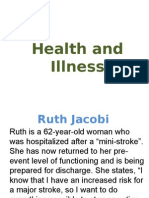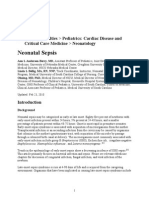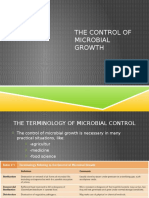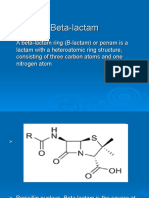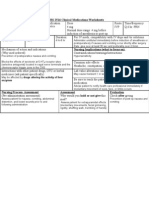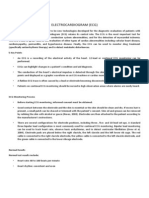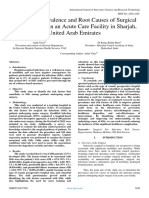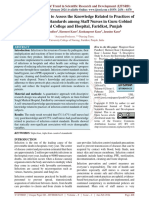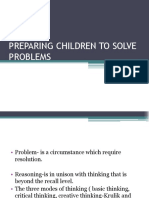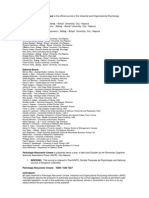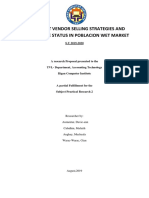Professional Documents
Culture Documents
Evaluation of Nurses Knowledges, Practices and Associated Factors Regarding Prevention of Surgical Site Infection
Copyright
Available Formats
Share this document
Did you find this document useful?
Is this content inappropriate?
Report this DocumentCopyright:
Available Formats
Evaluation of Nurses Knowledges, Practices and Associated Factors Regarding Prevention of Surgical Site Infection
Copyright:
Available Formats
Volume 5, Issue 10, October – 2020 International Journal of Innovative Science and Research Technology
ISSN No:-2456-2165
Evaluation of Nurses Knowledges, Practices and
Associated Factors Regarding Prevention of Surgical
Site Infection
Arbëresha Gurguri
Faculty of Public Health
University “Ismail Qemali” Vlorë, Albania
Abstract:- Surgical site infection (SSI) is one of the most Conclusions:
common types of Healthcare-Associated infection The results suggest that increasing knowledge and
accounting for 14% to 16% of all nosocomial infections focusing on some certain areas of prevention of SSI in
among hospitalized surgical patients. SSI is a significant practice need to be improved ,with a direct impact on
clinical problem associated to post-operative morbidity patient’s life and enhancing health care quality.
,resulting serious consequences in patients’ health ,
prolonged hospital stay and increasing costs. Keywords:- Knowledge, Nurses, Practice, Prevention,
Surgical Site Infection.
Purpose of the study:
Aimed at assessing level of knowledge of nurses and I. INTRODUCTION
associated factors regarding prevention of SSI in surgical
units of Vlora and Fier Hospital and to determine SSI is one of the most common nosocomial infections
relationship between both variables. in surgical patients. In United State of America Surgical site
infection account for 14%-16% of all health care associated
Method and Material: infections 1.
A cross-sectional descriptive study included 66
randomly selected nurses who completed an anonymus Surgical site infection (SSI) is defined as an infection
questionnaire regarding surgical site infections during that occurs after an operation within 30 days if no implant or
the period of study .The statistical analysis included the within one year if an implant is inserted into the organ 1.
calculation of averages, frequencies and percentages
while the Chi-Square test was used for the relationship Risk factors associated with the development of SSI
between the variables . To see the relative effect of are Intrinsic and extrinsic factors. Intrinsic factors referred to
independent variables on the dependent variable, advance age, malnutrition, metabolic diseases, smoking,
regression analysis was carried out. obesity, hypoxia, immune suppression, and length of pre-
operative stay2. Extrinsic factors referred to duration and
Results: application of skin antiseptics, preoperative shaving,
The findings revealed that the majority of nurses antibiotic prophylaxis, pre-operative skin preparation,
(65%) had average knowledge and good practices (46%) inappropriate sterilization of instruments, surgical drains,
regarding the prevention of surgical site infection. There surgical technique, surgical hand scrubs, and dressing
was a significant relationship between the gender of the techniques 2. 25 % of infections can be prevented by nurses
nurses and level of knowledge (p=0.001).Regarding by implementing standard precautionary measures during
nursing practice, there were significant relationships care of the surgical patients. Nurses can help to prevent
between age of nurses and level of practices (p=0.017). surgical site infection, reduces patient costs, economic
One area of their knowledge were at very low level burden and increase patient’s quality of life through their
including understanding prevention of infection for knowledge and recommended practices3.
lengthy operation . Some areas of practices were less
practicing including: advising patients to shower before This study is an attempt to asses knowledge of health
surgery with antimicrobial agents. There were no care professionals about SSI control and their usual practices
statistically significant differences between knowledges in operation theatres/wards to control or prevent them. The
and practice of the respondents in both hospitals while study findings will help the organizations in developing the
there have been observed some important relationships training programs by evaluating the gaps between
between specific questions of knowledge with nurses knowledge and practices of nurses related with prevention of
practices. surgical site infection. Appropriate knowledge and good
practices by the nurses can improve patient care and may
decrease the rate of infection in the hospitals.
IJISRT20OCT263 www.ijisrt.com 688
Volume 5, Issue 10, October – 2020 International Journal of Innovative Science and Research Technology
ISSN No:-2456-2165
II. METHODOLOGY receives score 1 and incorrect response will have 0. Those
participants who scored less than 5 points were categorized
The descriptive correlation study was conducted to as “Poor knowledge” , those who scored 6-8 points were
evaluate the level of knowledge and practice of surgical categorized as “Average knowledge” and those who scored
nurses and identify the association between knowledge and 9- 10 points were categorized as “Good knowledge” .
practice regarding prevention of surgical site infection.
Study data were collected from surgical wards of Fieri Nurses’s practices in the prevention of SSIs were
Hospital and Vlora Hospital. Nurses, working in surgical measured by 10 questions in which responses were answered
wards were included in the study. in a 5-point Likert scale (never practiced, rarely practiced
,sometimes practiced, often practiced and always practiced).
Study Design: Cross-sectional descriptive design, was Total score range from 1 to 5. Those participants who scored
carried out in surgical units of Fieri Hospital and Vlora less than 40 points were categorized as “Poor Practice” ,
Regional Hospital for period of October 2018 to March those who scored 41-45 points were categorized as “
2019. Average knowledge “ and those with more than 45 points
were categorized as “Good Practice”.Demographic
Sample of the Study: Non probability sampling was characteristics of all respondents were presented as
conducted .The sample consisted of 66 nurses working in frequencies and percentages.
the surgical units and operating theatre ,who were present
during the study period and who agreed to participate in the Statistical analysis: The data of the study were analyzed by
study. using (SPSS-version.19) program. Frequencies and
Percentages used to describe the study variables. The Chi-
Study Instrument: A questionnaire which was adopted by square test is used for determining the relationships between
Sickder et al 3 consisted from 29 items which include three sociodemographic data and nurses knowledges, practices
parts. First part assessed socio-demographic features of regarding prevention of surgical site infection and to see the
study participants like age, gender, educational qualification, correlation between knowledge and practice scores. A
total work experience, experience in surgical units, regression analysis was carried out to determine the relative
organization, participating in training programs , availability effect of independent variables on the dependent
of infection protocol (IP) guidelines, usage of IP guidelines . variable.Testing the significant association for this study was
Second part consists of questions which assessed used the significant P-value ≤ 0.05.
knowledge of participants regarding prevention of SSI, third
part had questions which assessed various practices III. RESULTS
followed in units and operation theatre and compared with
standard practices according to WHO infection control The characteristics of the respondents in both hospitals
protocols. are presented in Table (1). Table (1) shows that a total of 41
nurses (62.1%) from Fieri hospital and 25 (37.9%) from
The researcher divided collected scores into 3 levels. Vlora hospital were contributed in the study. Most of
The outcome measures of this study were knowledge (good subjects were female (74.2%).and (25.8%) were male
knowledge / average knowledge and poor knowledge) and nurses.
practice (good practice/ average practice and poor practice),
while the independent variables included sociodemographic Nurses’ age ranged between 25 to 45 years.
factors. Respondent qualification represents that most of the subjects
had completed a Master degree(54.5%) followed by (43.9%)
Nurses’s knowledge regarding the prevention of SSIs BSc degree and (1.5%) diploma nurses. According to table
was measured by 10 questions with “Yes” and “No” , in (1) (27.3%) n=18 of subjects have less than 1 year total
which “Yes” is the correct answer and “No” the incorrect work experience and 6-10 year total work experience, n=19
answer. The questions refered to the most important (28.8%) have 1-5 year experience and only n=11(16.7%)
recommendations by the WHO infection prevention and have above 10 year experience.Only 29 (43.9%) of the study
patient safety guideline (presurgical skin preparation, hand participants claim they were trained in the infectious control
hygiene etc.). The correct response for each question program.
IJISRT20OCT263 www.ijisrt.com 689
Volume 5, Issue 10, October – 2020 International Journal of Innovative Science and Research Technology
ISSN No:-2456-2165
Demographic data
Characteristics Frequency Percentage
Male 17 25.8%
Gender
Female 49 74.2%
<25years 12 18.2%
26-35years 43 65.2%
Age
36-45years 9 13.6%
>45years 2 3.0%
BSN 29 43.9%
Qualification MSN 36 54.5%
Secondary Nursing School 1 1.5%
<1 year 18 27.3%
Total work 1-5 years 19 28.8%
Experience 6-10 years 18 27.3%
>10 years 11 16.7%
<1 year 10 15.2%
Work experience in 1-5 years 37 56.1%
surgical ward 6-10 years 15 22.7%
>10 years 4 6.1%
Attending in training Yes 29 43.9%
programs No 37 56.1%
Availability of IP Yes 31 47.0%
guidelines No 35 53.0%
Usage of IP Yes 20 64.5%
guidelines No 11 35.5%
Fieri Hospital 41 62.1%
Organization
Vlora Hospital 25 37.9%
Table (1): Socio Demographic Characteristics of study sample (n = 66).
Frequency of Correct Percentage of Correct
Questions
Answers Answers
Does pre-operative shaving performed in day before surgery? 66 100%
Does staff existing and reentering the theater affect the incidence of
58 87.9%
surgical site infection?
Are preoperative showers with antiseptics are cost effective in
51 77.3%
preventing surgical site infection?
Does removal of jewelry, artificial nails and nail polish reduces the
46 69.7%
incidence of surgical site infection?
Does the puncture rate of surgical gloves correlate with the incidence
46 69.7%
of surgical site infection?
Does administration of prophylactic antibiotics help in preventing
62 93.9%
surgical site infection?
Does increased pain and discharge from wound site indicate surgical
55 83.3%
site infection?
Does time period of operation have effect developing surgical site
15 22.7%
infection?
Does surgical patients with compromised immune system have more
55 83.3%
chance of developing surgical site infection?
Prolong preoperative hospitalization associated with development of
42 63.6%
surgical site infection?
Table (2) : Knowledge of Nurses Regarding Prevention of Surgical Site Infections.
IJISRT20OCT263 www.ijisrt.com 690
Volume 5, Issue 10, October – 2020 International Journal of Innovative Science and Research Technology
ISSN No:-2456-2165
Table (2 )shows the responses of the subjects to each Responses of the subjects to another important
of the knowledge question which show that most of the question which refers that time period of operation has effect
nurses have average knowledge about surgical site infection. developing surgical site infection 15 (22.7%) participants
Responses of knowledge of nurses for the best time for pre- were agree about the statement and 51(77.3%) of nurses
operative shaving results that all 66 (100%)were responded knew that preoperative showers with antiseptics are cost
correctly which show that they know about it. Another effective in preventing surgical site infection.
question about staff existing and reentering the theater effect
the incidence of surgical site infection, in which 58 (87.9%) 55(83.3%) of study sample answered the question
nurses responded correctly ,while 46 (69.7 %) replied that increased discharge and pain from wound site indicate
correctly for the question that puncture rate of the surgical surgical site infection correctly and knew that surgical
gloves correlate with the incidence of surgical site infection patients with suppressed immune system were more at risk
,which result that most of the subjects have information of developing surgical site infection Participants of the study
about the significance of wearing gloves during procedure. were asked about the administration of prophylactic
antibiotics in preventing surgical site infection for which
Similarly the response of the subjects to another 62(93.9%) response of the participants were correct while
statement that removal of jewelry, artificial nails and nail 42(63.6%) of participants knew that prolong preoperative
polish reduces the incidence of surgical site infection , which stay is related with development of surgical site infection.
show that most of the participants 46(69.7%) have
knowledge about this question.
Frequency Percentage
Knowledge Level
n %
Low 4 6.06%
Average 43 65.15%
Good 19 28.79%
Table (3) :Description of nurses’ knowledge level regarding prevention of surgical site infection.
The results in the Table (3) shows that the level of total knowledge score of the study participants was 7.52 ±1.32 .
knowledge regarding surgical site infection in this group of 28.79% of participants had good knowledge of surgical site
participants was at average level (65.15%) about the surgical infection prevention followed by low level of knowledge
site infection and its prevention, with minimum score of 5 (6.06%).
and a maximum score of 10 out of 10 items . The mean
Always Often Sometimes Rarely Never
Questions n%
n% n% n% n%
I wash my hands before and after changing wound
57 9
dressing and touching the surgical site
86.4% 13.6% 0 0 0
0% 0% 0%
34 26
I wash my hands before wearing sterile gloves 6 0 0
51.5% 39.4%
9.1% 0% 0%
49 7
I perform pre-operative shaving right before surgery 1 3 6
74.2% 10.6%
1.5% 4.5% 9.1%
I administer pre-operative prophylactic antibiotic 38 18
within one hour before surgery 57.6% 27.3% 5 2 3
7.6% 3% 4.5%
I advice my patient to take pre-operative showering 24 15
with antimicrobial agent 36.4% 22.7% 19 7 1
28.8% 10.6% 1.5%
I use sterilized dressing materials for cleansing 54 12
surgical wound dressing 81.8% 18.2% 0 0 0
0% 0% 0%
IJISRT20OCT263 www.ijisrt.com 691
Volume 5, Issue 10, October – 2020 International Journal of Innovative Science and Research Technology
ISSN No:-2456-2165
Always Often Sometimes Rarely Never
Questions n%
n% n% n% n%
I use an antiseptic technique during surgical wound
42 16
dressing 8 0 0
63.6% 24.2%
12.1% 0% 0%
55 10 0 1 0
I assess and monitor surgical site condition
83.3% 15.2% 0% 1.5% 0%
I use face mask during cleansing surgical wound 22 18
23 3 0
dressing 33.3% 27.3%
34.8% 4.5% 0%
I separate infected from non-infected cases during
58 8
dressing 0 0 0
87.9% 12.1%
0% 0% 0%
Table (4): Practice of Nurses Regarding Prevention of Surgical Site Infections.
Table (4 )shows the responses of the subjects to each The responses of practice questionnaire with highest
of the practice question which shows that (36.4%) of nurses percentage of nurses “always practice” were : performing
always advised surgical patients about performing pre- hand washing before and after changing dressing and
operating showering with antimicrobial agents and (33.3%) touching the surgical site ( 86.4%), using sterile dressing
of them used always face mask during cleansing surgical materials for performing wound dressing (81.8%), assessing
wound. and monitoring surgical site condition (83.3%) and
separating infected from non-infected materials during
These results indicated that some nurses have poor dressing (87.9%).
practice in these areas.
Frequency Percentage
Practice Level
n %
Low 8 12.12%
Average 27 40.91%
Good 31 46.97%
Table (5): Description of nurses’practice level regarding prevention of surgical site infection.
The results shown in table(5) revealed that of 10 items . The mean practice score of the study
nurses’practice of surgical site infection was at good level participants was 44.68 ±3.47. ( 40.91%) of study participants
(46.97%) about the surgical site infection and its prevention, had average practice and only 12.12% of them had practice
with minimum score of 34 and a maximum score of 50 out at low level towards prevention of surgical site infection.
Knowledge of nurse’s Practice of nurse’s
Demographic Data
P-value P-value
Sex 0.001* 0.153
Age 0.810 0.017*
Organization 0.875 0.567
Qualification 0.661 0.135
Total work Experience 0.758 0.805
Work Experience in surgical ward 0.140 0.796
Attending in training programs 0.696 0.393
Availability of IP guidelines 0.492 0.533
Usage of IP guidelines 0.710 0.243
Table (6): Differences in nurses’ knowledge and practice with respect to selected sociodemographics
Significant at p
IJISRT20OCT263 www.ijisrt.com 692
Volume 5, Issue 10, October – 2020 International Journal of Innovative Science and Research Technology
ISSN No:-2456-2165
IV. DISCUSSION The findings of this study are similar to a study which
was done by Joshi7 in India in which nurses‟ practice
The aim of this study was to assess the knowledge and regarding surgical site infection prevention was also at high
practice of nurses and identify factors associated with them level. The results are in the same line to a study which in
regarding prevention of surgical site infections and examine Ethiopia, in which nurses‟ practice were at good level 8. For
the relationships they have. the others item of practice, it was shown that nurses lacked
in some areas of practice where, 1.5% of nurses never
1.Knowledge Regarding Prevention of SSI advised surgical patients about performing pre-operating
The findings highlight ed that total knowledge showering with antimicrobial agents. Another study found
regarding the prevention of SSI was at average level of also some nurses lacked practice in these area.3
knowledge. The majority of the nurses had a Master degree
in nursing (54.5%). (56.1%) of nurses had not been trained
in the infection control training programs. The findings 3.Relationship between Nurses’ knowledge and practice
showed that the working experience in the surgical wards of with demographic variables regarding prevention of
subjects was 1-5 years (56.1%). surgical site infection.
The analysis reveals statistically significant differences
The appropriate timing for removing the hair at the between knowledges of female and male nurses. 90% of
incision site was answered correctly in 100% of nurses . A nurses with good knowledge are women, 75% of nurses with
previous study3 found that only (24.20%)of subjects average knowledge are women and all nurses with low
correctly answered that pre-operative shaving should be knowledges are men. ODDS (good / average) = 2,988
done immediately before the operation. indicates that the probability of having good knowledge in
women is approximately 3 times higher than in men.
The study also revealed that participant’s sex was ODDS(low / average) = 0.0001 indicates that the probability
significantly associated with knowledge regarding of having low knowledge in women is as much as 1/1000 of
prevention of surgical site infection. The results of present men.
study4 agree with they evaluate the knowledge, attitude and
efficacy of nursing staffs in hospital about infections control The analysis showed that there are statistically
they revealed that there a significant relationship between significant differences between nurses practices and
knowledge and gender. A similar study5 has also found that different ages. 63% of nurses with low practice are under 25
the gender is significantly associated with knowledge of SSI years of age, while those with average and good practice are
prevention. in the 26-35 age group (67% and 74%).ODDS (good /
average) = 0.001 indicates that the probability of good
The odd of female nurse’s was almost 3 times higher practices in the age group of up to 45 years is 1/1000 of the
to have good knowledge than males regarding prevention of probability of over 45 years of age in nurses. ODDS (low /
surgical site infections. The possible reasons for this result average) = 4.219 indicates that the probability low practices
might be due to the fact that in this study the proportion of <25 years of age is 4 times higher than those> 45 years old.
females was higher compared to females.
According to a study nurses who were 30 years and
There were no significant difference between above were found being about 2 times more likely to
demographic variables(age, organization, qualification, total practice surgical site infection prevention actives compared
work experience , work experience in surgical ward , to those who were less than 30 years (AOR = 1.79, 95%
attending in training programs, availability of IP guidelines CI)8. Results in this study agree with Kang, et al 9 they
in both hospitals, usage of IP guidelines ) with level of evaluated hospital nurses' knowledge and compliance on
knowledge ‘nurses regarding prevention of surgical site multidrug-resistant organism infection control guideline, in
infections. Korea, they showed that there were significant relationship
between nursing practice and age and the type of units
Another study also revealed that training program did .Correlation analysis showed that there were no statistical
not effect any significant difference in the knowledge level differences between knowledge and practice of nurses.
between control and experimental groups 6. Another study had found no relationships between
knowledge and practice in infection prevention measures 10.
Moreover, this finding is also in agreement with
another study5 where , no significant relationship was found The study concludes that the majority of nurses had
between job position, ward, enrolment in SSI prevention average level of knowledge and good level of practices
program and practice score. (46%) regarding the prevention of surgical site infection.
There were significant relationship between the
2.Practice Regarding Prevention of SSI nurses’knowledge and gender and between nurses’ practice
The findings showed that total practice regarding the and ages at p≥0.05 value. The results and conclusions of the
prevention of SSI was at a good level (46.97%). This study suggest that increasing knowledge and focusing on
indicated that nurses had good nursing practice for the some specific areas of prevention of SSI in practice need
prevention of SSI. improvement ,with a direct impact on patient’s safety and
enhancing health care quality. Hospital institutions should
IJISRT20OCT263 www.ijisrt.com 693
Volume 5, Issue 10, October – 2020 International Journal of Innovative Science and Research Technology
ISSN No:-2456-2165
provide for implementation standard guidelines for the
prevention of surgical site infection in the surgical units.
REFERENCES
[1]. Mangram, A. J., Horan, T. C., Pearson, M. L., Silver,
L. C., & Jarvis, W. R. (1999). Guideline for prevention
of surgical site infection, 1999. Hospital Infection
Control Practices Advisory Committee. Infection
Control Hospital Epidemiology, 20, 250- 278.
[2]. Nandi, P. L., Rajan, S. S., Mak, K. C., Chan, S. C., &
So, Y. P. (1999). Surgical wound infection. Hong
Kong Medical Journal, 5, 82-86.
[3]. Sickder, H. K., Sae-Sia, W., & Petpichetchian, W.
(2014). Nurses‟ Knowledge and Practice Regarding
Prevention of Surgical Site Infection inBangladesh.
[4]. Ghadmgahi, F.; Zighaimat, F.; Ebadi, A. and
Houshmand, A.:"Knowledge, attitude and self-efficacy
of nursing staffs in hospital infections control." Journal
Mil Med ,13.3, (2011), PP : 167-172
[5]. Alabdulrazaq1, E.; Mutairi, A. H ; AlHsaon, M;
Alsaigh, S.(2018) Knowledge and practice towards
prevention of surgical site infection among healthcare
professionals in Buraidah city, Saudi Arabia.
International Journal of Medical and Health Research
121 International Journal of Medical and Health
Research ISSN: 2454-9142 Received: 17-08-2018;
Accepted: 19-09-2018
www.medicalsciencejournal.com Volume 4; Issue 10;
October 2018; Page No. 121-127
[6]. Benneth, B. L., & Weale, A. (1997). HIV and AIDS
awareness: An evaluation of short training programme
for Midwives. Journal of Advanced Nursing, 26, 273-
282.
[7]. Joshi, R. (2014). A Study to assess the Knowledge and
Practice of Staff Nurses Regarding Prevention of
Surgical Site Infection among Selected Hospital in
Udaipur City. International Journal of Nursing Care,
2(2), 78-80
[8]. Teshager, F. A., Engeda, E. H., & Worku, W. Z.
(2015). Knowledge, Practice, and Associated Factors
towards Prevention of Surgical Site Infection among
Nurses Working in Amhara Regional State Referral
Hospitals, Northwest Ethiopia. Surgery research and
practice, 2015.
[9]. Kang, J.; Cho, J.; Kim, Y.;Kim, D.H.; Lee, J.; et al
.:"Hospital nurses' knowledge and compliance on
multidrug-resistant organism infection control
guideline." Journal of Korean Academy of Nursing,
39.2, (2009), PP : 186-197.
[10]. Vij, A., Williamson, S. N., & Gupta, S. (2001).
Knowledge and practice of nursing staff towards
infection control measures in a tertiary care hospital.
Journal of the Academy of Hospital Administration,
13(2), 1-6
IJISRT20OCT263 www.ijisrt.com 694
You might also like
- Intracerebral Haemorrhage: Disease PrimersDocument18 pagesIntracerebral Haemorrhage: Disease PrimersMarlon VillanuevaNo ratings yet
- Argumentative Research EssayDocument5 pagesArgumentative Research Essayckjennings6100% (1)
- Managing Nause and Vomiting-Crit-Care-Nurse-2003-Garrett-31-50 PDFDocument22 pagesManaging Nause and Vomiting-Crit-Care-Nurse-2003-Garrett-31-50 PDFpmuftiaNo ratings yet
- Case Study, Chapter 42, Management of Patients With Musculoskeletal TraumaDocument2 pagesCase Study, Chapter 42, Management of Patients With Musculoskeletal TraumaAhmad BaolayyanNo ratings yet
- Assesment Diagnosis Inference Objective Intervention Raionale Evaluation Subjective: Objective: Long Term Goal: Goal MetDocument2 pagesAssesment Diagnosis Inference Objective Intervention Raionale Evaluation Subjective: Objective: Long Term Goal: Goal MetChaeL90No ratings yet
- Case Study 4th Year 1st Sem 2 Final FixDocument30 pagesCase Study 4th Year 1st Sem 2 Final FixHerschel QuerimitNo ratings yet
- Week 7Document12 pagesWeek 7MARIKA BALONDONo ratings yet
- Arthroplasty JournalDocument3 pagesArthroplasty Journallina yohanes100% (1)
- Anti-infective Agents Chapter OverviewDocument13 pagesAnti-infective Agents Chapter OverviewEricka AbellaNo ratings yet
- Idiopathic Thrombocytopenic Purpura: Overview With Report of A CaseDocument4 pagesIdiopathic Thrombocytopenic Purpura: Overview With Report of A CaseHernan GonzalezNo ratings yet
- Tenofovir Disoproxil Fumarate: Therese M. Chapman, Jane K. Mcgavin and Stuart NobleDocument12 pagesTenofovir Disoproxil Fumarate: Therese M. Chapman, Jane K. Mcgavin and Stuart NobleBagusHibridaNo ratings yet
- Pharm 4 Fun Suzanne Morris MetronidazoleDocument2 pagesPharm 4 Fun Suzanne Morris MetronidazoleJasmyn RoseNo ratings yet
- Group 1 - HIV - Case StudyDocument30 pagesGroup 1 - HIV - Case StudyCONTRERAS, ALIANNA IRISHNo ratings yet
- Drug InteractionsDocument21 pagesDrug InteractionsPawan Deshmukh100% (1)
- Drug Study Adn Ncp-Case Pres.Document22 pagesDrug Study Adn Ncp-Case Pres.MaeNo ratings yet
- Antiviral Drugs Classification and MechanismsDocument56 pagesAntiviral Drugs Classification and MechanismsciccianoNo ratings yet
- EAMC DFCM OPD Charting Guidelines As of March 2022Document19 pagesEAMC DFCM OPD Charting Guidelines As of March 2022Adrian MaterumNo ratings yet
- Journal For MEdical WardDocument8 pagesJournal For MEdical WardValcrist BalderNo ratings yet
- Digoxin FABDocument6 pagesDigoxin FABqwer22No ratings yet
- New Patient Assessment and Care PlanDocument4 pagesNew Patient Assessment and Care PlanRalph Lawrence Ruiz Tagorda0% (1)
- HexaximeDocument12 pagesHexaximekanharitNo ratings yet
- Rifaximin Nihms443516Document10 pagesRifaximin Nihms443516MIHAELANo ratings yet
- HIV Case (Long Case)Document16 pagesHIV Case (Long Case)Max mitchyNo ratings yet
- DRUG STUDY-danaDocument3 pagesDRUG STUDY-danairish_estrellaNo ratings yet
- Zocor (Simvastatin)Document3 pagesZocor (Simvastatin)E100% (1)
- Drug StudyDocument8 pagesDrug StudyJay-ar Batara SorianoNo ratings yet
- Running Head: Pico Question: Aseptic Technique 1Document10 pagesRunning Head: Pico Question: Aseptic Technique 1api-253019091No ratings yet
- URINARY TRACT INFECTION CAUSES AND TREATMENTDocument6 pagesURINARY TRACT INFECTION CAUSES AND TREATMENTLourdes Fernandez CabreraNo ratings yet
- PoliomyelitisDocument4 pagesPoliomyelitisGerard Adad Misa100% (1)
- CHAPTER 4-Atty AliboghaDocument48 pagesCHAPTER 4-Atty AliboghaPaul EspinosaNo ratings yet
- Laboratory Results RosarioDocument6 pagesLaboratory Results RosarioAlexander Eli BeytonNo ratings yet
- A Guide On Intravenous Drug Compatibilities Based On Their PHDocument10 pagesA Guide On Intravenous Drug Compatibilities Based On Their PHSergio M JuniorNo ratings yet
- Case Study FinalDocument22 pagesCase Study FinalDave Cabuyadao0% (1)
- Nursing Care Plan for HIV/AIDS Patient with FatigueDocument2 pagesNursing Care Plan for HIV/AIDS Patient with FatigueAdha100% (1)
- Neonatal SepsisDocument39 pagesNeonatal SepsisBryan KernsNo ratings yet
- Patient Education: A Guide for NursesDocument32 pagesPatient Education: A Guide for Nursesاسامة محمد السيد رمضانNo ratings yet
- Peptic Ulcer DiseaseDocument8 pagesPeptic Ulcer Diseasepragna novaNo ratings yet
- Clabsi101 508Document53 pagesClabsi101 508Arjun KumarNo ratings yet
- Ketorolac PI PDFDocument2 pagesKetorolac PI PDFintan kusumaningtyasNo ratings yet
- RRS at RRLDocument19 pagesRRS at RRLNicole MangosanNo ratings yet
- Drug Order: Lonsurf (Trifluridine/TipiracilDocument3 pagesDrug Order: Lonsurf (Trifluridine/TipiracilKristine AcasioNo ratings yet
- Controlling Microbial Growth: Physical MethodsDocument30 pagesControlling Microbial Growth: Physical MethodsAyu WidyaNo ratings yet
- Beta LactamDocument18 pagesBeta LactamCesar Saba0% (1)
- PNRIDocument11 pagesPNRICharleen Joyce UsacdinNo ratings yet
- AMINOGLYCOSIDES AND MACROLIDES: MECHANISMS AND CLINICAL USESDocument45 pagesAMINOGLYCOSIDES AND MACROLIDES: MECHANISMS AND CLINICAL USESAbdullah EmadNo ratings yet
- Mesna: Mesna, Sold Under The BrandDocument17 pagesMesna: Mesna, Sold Under The BrandAndry HamdaniNo ratings yet
- Midterm Exam Antiinfective, Biotic, ViralDocument5 pagesMidterm Exam Antiinfective, Biotic, ViralJojo Justo100% (2)
- Medication Dosing Guidelines for Obese AdultsDocument8 pagesMedication Dosing Guidelines for Obese AdultsSarah Zielda NajibNo ratings yet
- Tetanus Toxoid Vaccine Nursing Care PlanDocument3 pagesTetanus Toxoid Vaccine Nursing Care PlanDwight DiazNo ratings yet
- The Doctors in ICU Need To Know The Basics Of.2Document9 pagesThe Doctors in ICU Need To Know The Basics Of.2Santiago Chávez100% (1)
- Zofran IVPDocument1 pageZofran IVPAdrianne Bazo100% (1)
- Pressure SoresDocument43 pagesPressure SoresArpanpatelNo ratings yet
- Mushtaq Ahmad: Running Head: REFLECTIVE LOG 1Document5 pagesMushtaq Ahmad: Running Head: REFLECTIVE LOG 1Shafiq Ur RahmanNo ratings yet
- HPV Virus Causes Recurrent Respiratory Papillomatosis in BoyDocument21 pagesHPV Virus Causes Recurrent Respiratory Papillomatosis in BoyDaffa IbnurasyNo ratings yet
- What Is Meningitis?Document7 pagesWhat Is Meningitis?laujeroNo ratings yet
- ElectrocardiogramDocument3 pagesElectrocardiogramladydreamer_92No ratings yet
- A Study of the Lack of Hiv/Aids Awareness Among African American Women: a Leadership Perspective: Awareness That All Cultures Should Know AboutFrom EverandA Study of the Lack of Hiv/Aids Awareness Among African American Women: a Leadership Perspective: Awareness That All Cultures Should Know AboutRating: 5 out of 5 stars5/5 (1)
- A Study of Prevalence and Root Causes of Surgical Site Infections in An Acute Care Facility in Sharjah, United Arab EmiratesDocument23 pagesA Study of Prevalence and Root Causes of Surgical Site Infections in An Acute Care Facility in Sharjah, United Arab EmiratesInternational Journal of Innovative Science and Research TechnologyNo ratings yet
- A Descriptive Study To Assess The Knowledge Related To Practices of Infection Control Standards Among Staff Nurses in Guru Gobind Singh Medical College and Hospital, Faridkot, PunjabDocument5 pagesA Descriptive Study To Assess The Knowledge Related To Practices of Infection Control Standards Among Staff Nurses in Guru Gobind Singh Medical College and Hospital, Faridkot, PunjabEditor IJTSRDNo ratings yet
- An Analysis on Mental Health Issues among IndividualsDocument6 pagesAn Analysis on Mental Health Issues among IndividualsInternational Journal of Innovative Science and Research TechnologyNo ratings yet
- Harnessing Open Innovation for Translating Global Languages into Indian LanuagesDocument7 pagesHarnessing Open Innovation for Translating Global Languages into Indian LanuagesInternational Journal of Innovative Science and Research TechnologyNo ratings yet
- Diabetic Retinopathy Stage Detection Using CNN and Inception V3Document9 pagesDiabetic Retinopathy Stage Detection Using CNN and Inception V3International Journal of Innovative Science and Research TechnologyNo ratings yet
- Investigating Factors Influencing Employee Absenteeism: A Case Study of Secondary Schools in MuscatDocument16 pagesInvestigating Factors Influencing Employee Absenteeism: A Case Study of Secondary Schools in MuscatInternational Journal of Innovative Science and Research TechnologyNo ratings yet
- Exploring the Molecular Docking Interactions between the Polyherbal Formulation Ibadhychooranam and Human Aldose Reductase Enzyme as a Novel Approach for Investigating its Potential Efficacy in Management of CataractDocument7 pagesExploring the Molecular Docking Interactions between the Polyherbal Formulation Ibadhychooranam and Human Aldose Reductase Enzyme as a Novel Approach for Investigating its Potential Efficacy in Management of CataractInternational Journal of Innovative Science and Research TechnologyNo ratings yet
- The Making of Object Recognition Eyeglasses for the Visually Impaired using Image AIDocument6 pagesThe Making of Object Recognition Eyeglasses for the Visually Impaired using Image AIInternational Journal of Innovative Science and Research TechnologyNo ratings yet
- The Relationship between Teacher Reflective Practice and Students Engagement in the Public Elementary SchoolDocument31 pagesThe Relationship between Teacher Reflective Practice and Students Engagement in the Public Elementary SchoolInternational Journal of Innovative Science and Research TechnologyNo ratings yet
- Dense Wavelength Division Multiplexing (DWDM) in IT Networks: A Leap Beyond Synchronous Digital Hierarchy (SDH)Document2 pagesDense Wavelength Division Multiplexing (DWDM) in IT Networks: A Leap Beyond Synchronous Digital Hierarchy (SDH)International Journal of Innovative Science and Research TechnologyNo ratings yet
- Comparatively Design and Analyze Elevated Rectangular Water Reservoir with and without Bracing for Different Stagging HeightDocument4 pagesComparatively Design and Analyze Elevated Rectangular Water Reservoir with and without Bracing for Different Stagging HeightInternational Journal of Innovative Science and Research TechnologyNo ratings yet
- The Impact of Digital Marketing Dimensions on Customer SatisfactionDocument6 pagesThe Impact of Digital Marketing Dimensions on Customer SatisfactionInternational Journal of Innovative Science and Research TechnologyNo ratings yet
- Electro-Optics Properties of Intact Cocoa Beans based on Near Infrared TechnologyDocument7 pagesElectro-Optics Properties of Intact Cocoa Beans based on Near Infrared TechnologyInternational Journal of Innovative Science and Research TechnologyNo ratings yet
- Formulation and Evaluation of Poly Herbal Body ScrubDocument6 pagesFormulation and Evaluation of Poly Herbal Body ScrubInternational Journal of Innovative Science and Research TechnologyNo ratings yet
- Advancing Healthcare Predictions: Harnessing Machine Learning for Accurate Health Index PrognosisDocument8 pagesAdvancing Healthcare Predictions: Harnessing Machine Learning for Accurate Health Index PrognosisInternational Journal of Innovative Science and Research TechnologyNo ratings yet
- The Utilization of Date Palm (Phoenix dactylifera) Leaf Fiber as a Main Component in Making an Improvised Water FilterDocument11 pagesThe Utilization of Date Palm (Phoenix dactylifera) Leaf Fiber as a Main Component in Making an Improvised Water FilterInternational Journal of Innovative Science and Research TechnologyNo ratings yet
- Cyberbullying: Legal and Ethical Implications, Challenges and Opportunities for Policy DevelopmentDocument7 pagesCyberbullying: Legal and Ethical Implications, Challenges and Opportunities for Policy DevelopmentInternational Journal of Innovative Science and Research TechnologyNo ratings yet
- Auto Encoder Driven Hybrid Pipelines for Image Deblurring using NAFNETDocument6 pagesAuto Encoder Driven Hybrid Pipelines for Image Deblurring using NAFNETInternational Journal of Innovative Science and Research TechnologyNo ratings yet
- Terracing as an Old-Style Scheme of Soil Water Preservation in Djingliya-Mandara Mountains- CameroonDocument14 pagesTerracing as an Old-Style Scheme of Soil Water Preservation in Djingliya-Mandara Mountains- CameroonInternational Journal of Innovative Science and Research TechnologyNo ratings yet
- A Survey of the Plastic Waste used in Paving BlocksDocument4 pagesA Survey of the Plastic Waste used in Paving BlocksInternational Journal of Innovative Science and Research TechnologyNo ratings yet
- Hepatic Portovenous Gas in a Young MaleDocument2 pagesHepatic Portovenous Gas in a Young MaleInternational Journal of Innovative Science and Research TechnologyNo ratings yet
- Design, Development and Evaluation of Methi-Shikakai Herbal ShampooDocument8 pagesDesign, Development and Evaluation of Methi-Shikakai Herbal ShampooInternational Journal of Innovative Science and Research Technology100% (3)
- Explorning the Role of Machine Learning in Enhancing Cloud SecurityDocument5 pagesExplorning the Role of Machine Learning in Enhancing Cloud SecurityInternational Journal of Innovative Science and Research TechnologyNo ratings yet
- A Review: Pink Eye Outbreak in IndiaDocument3 pagesA Review: Pink Eye Outbreak in IndiaInternational Journal of Innovative Science and Research TechnologyNo ratings yet
- Automatic Power Factor ControllerDocument4 pagesAutomatic Power Factor ControllerInternational Journal of Innovative Science and Research TechnologyNo ratings yet
- Review of Biomechanics in Footwear Design and Development: An Exploration of Key Concepts and InnovationsDocument5 pagesReview of Biomechanics in Footwear Design and Development: An Exploration of Key Concepts and InnovationsInternational Journal of Innovative Science and Research TechnologyNo ratings yet
- Mobile Distractions among Adolescents: Impact on Learning in the Aftermath of COVID-19 in IndiaDocument2 pagesMobile Distractions among Adolescents: Impact on Learning in the Aftermath of COVID-19 in IndiaInternational Journal of Innovative Science and Research TechnologyNo ratings yet
- Studying the Situation and Proposing Some Basic Solutions to Improve Psychological Harmony Between Managerial Staff and Students of Medical Universities in Hanoi AreaDocument5 pagesStudying the Situation and Proposing Some Basic Solutions to Improve Psychological Harmony Between Managerial Staff and Students of Medical Universities in Hanoi AreaInternational Journal of Innovative Science and Research TechnologyNo ratings yet
- Navigating Digitalization: AHP Insights for SMEs' Strategic TransformationDocument11 pagesNavigating Digitalization: AHP Insights for SMEs' Strategic TransformationInternational Journal of Innovative Science and Research Technology100% (1)
- Drug Dosage Control System Using Reinforcement LearningDocument8 pagesDrug Dosage Control System Using Reinforcement LearningInternational Journal of Innovative Science and Research TechnologyNo ratings yet
- The Effect of Time Variables as Predictors of Senior Secondary School Students' Mathematical Performance Department of Mathematics Education Freetown PolytechnicDocument7 pagesThe Effect of Time Variables as Predictors of Senior Secondary School Students' Mathematical Performance Department of Mathematics Education Freetown PolytechnicInternational Journal of Innovative Science and Research TechnologyNo ratings yet
- Formation of New Technology in Automated Highway System in Peripheral HighwayDocument6 pagesFormation of New Technology in Automated Highway System in Peripheral HighwayInternational Journal of Innovative Science and Research TechnologyNo ratings yet
- An Approach To Determine Probability of Third-Party Damage To Cross-Country Pipelines in IndiaDocument16 pagesAn Approach To Determine Probability of Third-Party Damage To Cross-Country Pipelines in IndiaJoseNo ratings yet
- Rais12 SM CH21Document33 pagesRais12 SM CH21Christel YeoNo ratings yet
- Preparing Children To Solve ProblemsDocument31 pagesPreparing Children To Solve ProblemsJennylyn Layan AlnajesNo ratings yet
- Lecture 1 IntroductionDocument12 pagesLecture 1 Introductionashwat kumarNo ratings yet
- 1 Probability and StatisticsDocument3 pages1 Probability and StatisticsJoy DacuanNo ratings yet
- Example 10 Test of HypothesisDocument3 pagesExample 10 Test of HypothesisPorosh Uddin Ahmed TaposhNo ratings yet
- CCPDocument65 pagesCCPnaveeth11No ratings yet
- Self-Medication Prevalence and Related Factors Among Baccalaureate Nursing StudentsDocument8 pagesSelf-Medication Prevalence and Related Factors Among Baccalaureate Nursing StudentsTJPRC PublicationsNo ratings yet
- Prevalence of Financial Fraud and Scams Among Older Adults in The United States: A Systematic Review and Meta-AnalysisDocument9 pagesPrevalence of Financial Fraud and Scams Among Older Adults in The United States: A Systematic Review and Meta-AnalysisEduardo Santana SuárezNo ratings yet
- Lecture 2.bb - Secondary DataDocument8 pagesLecture 2.bb - Secondary DataRodrigo VázquezNo ratings yet
- CFS Cloud Implementation in OrganizationsDocument192 pagesCFS Cloud Implementation in OrganizationsDaniela TalmaciuNo ratings yet
- EPDDocument174 pagesEPDVlipperNo ratings yet
- Working PapersDocument21 pagesWorking PapersMhmd HabboshNo ratings yet
- Vol6 2 2008-LibreDocument143 pagesVol6 2 2008-LibrePsiholog Doina LupuNo ratings yet
- Undergraduate Music Dissertation ExamplesDocument5 pagesUndergraduate Music Dissertation ExamplesOnlinePaperWritersUK100% (1)
- PPP Advantages Disadvantages PDFDocument33 pagesPPP Advantages Disadvantages PDFHammad AhmedNo ratings yet
- Bridging Facility Maintenance Gap Using BIMDocument31 pagesBridging Facility Maintenance Gap Using BIMfatileNo ratings yet
- Appleton & Lange Review of Anatomy, Sixth Edition: NoticeDocument1 pageAppleton & Lange Review of Anatomy, Sixth Edition: NoticeSomiZafarNo ratings yet
- Hyper StarDocument21 pagesHyper StarSaigha ArshadNo ratings yet
- Background of StudyDocument4 pagesBackground of StudyAnonymous QVEYNeNo ratings yet
- Metallurgical Condition AssessmentDocument2 pagesMetallurgical Condition AssessmentJohnNo ratings yet
- Analysis of The Case "Leadership Anxiety at PharmOrg"Document14 pagesAnalysis of The Case "Leadership Anxiety at PharmOrg"Andy VicenteNo ratings yet
- Lesson Plan CritiqueDocument3 pagesLesson Plan Critiqueapi-357257220No ratings yet
- Chilton 1999 Material MeaningsDocument267 pagesChilton 1999 Material MeaningsGabriel Rivera BravoNo ratings yet
- Test Suite Generation With Memetic Algorithms: Gordon Fraser Andrea Arcuri Phil McminnDocument8 pagesTest Suite Generation With Memetic Algorithms: Gordon Fraser Andrea Arcuri Phil McminnJatin GeraNo ratings yet
- Online Glossary For Ap Psychology WeeblyDocument52 pagesOnline Glossary For Ap Psychology Weeblyapi-276687593No ratings yet
- Alemzewed AyeleDocument115 pagesAlemzewed AyeleYidnekachew hailuNo ratings yet
- Literature ReviewDocument8 pagesLiterature Reviewtaiba tariqNo ratings yet
- Alternate Dispute ResolutionDocument12 pagesAlternate Dispute ResolutionsahilkaushikNo ratings yet
- The Market Vendor Selling Strategies and Their Income Status in Poblacion Wet MarketDocument10 pagesThe Market Vendor Selling Strategies and Their Income Status in Poblacion Wet MarketEbyang LadishNo ratings yet





























